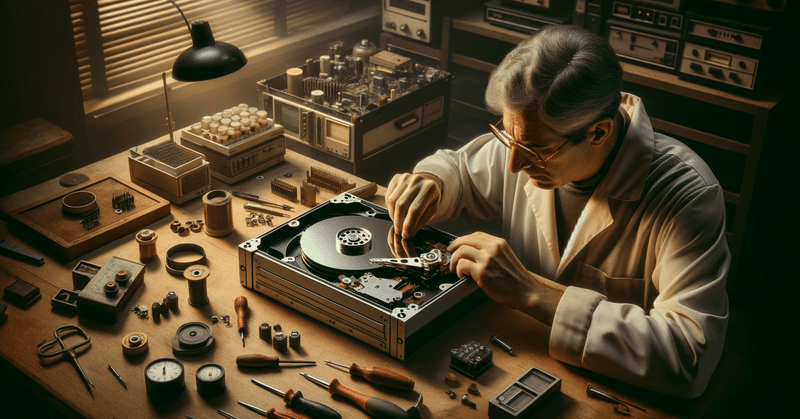
70年代に誕生したremovable drive(RL02) 。機能を理解することに役立つ!
The RL02 disk drive, developed by Digital Equipment Corporation (DEC), was an important part of the computer storage landscape in the 1970s. It was introduced as an improvement over its predecessor, the RL01, offering increased storage capacity and performance for users of DEC's PDP and VAX computer systems. Here are some of the key features of the RL02:
Storage Capacity: The RL02 offered a storage capacity of 10.5 megabytes, which was double the capacity of the RL01. This increase in storage capacity allowed for more data to be stored on a single disk, reducing the need for disk swaps and improving the efficiency of data management.
Removable Disk Packs: Like the RL01, the RL02 used 14-inch removable disk packs. This feature allowed users to easily switch between different sets of data or programs by simply changing the disk pack, facilitating data transport and storage flexibility.
Compatibility: The RL02 was designed to be backward compatible with the RL01, meaning it could read disks formatted for the RL01. This compatibility feature was crucial for ensuring a smooth transition for existing DEC customers who were upgrading their storage solutions.
Improved Data Access: The RL02 featured improvements in data access times compared to its predecessor. These improvements were achieved through enhancements in the drive's mechanics and electronics, allowing for faster seek times and data transfer rates. This resulted in better overall system performance.
Durability and Reliability: DEC was known for producing durable and reliable products, and the RL02 was no exception. The drive was designed to withstand the rigors of frequent use, including the insertion and removal of disk packs, making it a reliable choice for businesses and institutions.
Integration with DEC Systems: The RL02 was specifically designed to integrate seamlessly with DEC's range of mini and microcomputers, such as the PDP-11 and VAX systems. This ensured that users of DEC's computing systems could easily incorporate the RL02 into their existing setups without compatibility issues.
Form Factor and Design: The drive was housed in a cabinet that could be either standalone or rack-mounted, depending on the user's space and configuration needs. Its design was in line with the aesthetic and practical design principles of DEC's other products from the same era.
The RL02 represented a significant step forward in the evolution of magnetic disk storage technology. Its introduction provided DEC's customers with a more capable and flexible storage solution, reinforcing DEC's position as a leading provider of computer systems and peripherals during that time.
The seek feature in the context of the DEC RL02 disk drive refers to the mechanism by which the drive positions its read/write head over the correct track on the disk where data needs to be read from or written to. The RL02, as a disk storage device introduced by Digital Equipment Corporation (DEC) in the late 1970s, was designed to work with DEC's PDP-11, VAX, and other computer systems of that era. The seek operation is crucial for disk drives because it significantly affects the overall access time to data. Here's a detailed look into how the seek feature worked in the RL02 and its characteristics:
Seek Mechanism and Control: The RL02 used a voice coil actuator for the seek mechanism. The actuator moved the read/write head across the disk surface to the required track. This movement was controlled by the drive's electronics, which received a command from the computer system specifying the track number where the data was located.
Seek Time: Seek time is the duration taken by the drive to move the head from its current position to the target track. It's a critical performance metric for any disk drive. The RL02's seek time would vary depending on the distance between the starting and target tracks, with shorter seeks taking less time and longer seeks taking more. The average seek time for the RL02 was designed to be competitive for its era, optimizing access times for the data storage and retrieval needs of the systems it supported.
Positioning and Accuracy: Once the seek operation initiated, the drive needed to accurately position the head over the correct track. The RL02 employed a servo mechanism to ensure precision. This servo mechanism could use embedded servo information on the disk to fine-tune the head's position, ensuring it aligned accurately over the track to avoid off-track errors during read/write operations.
Optimization and Performance: To optimize performance, disk drives including the RL02 aimed to minimize seek times through efficient algorithms. These could involve scheduling read/write operations in a manner that minimized the total head movement or predicting the next required track to pre-position the head. Such optimizations were crucial for improving the throughput and efficiency of the drive.
Impact on System Performance: The efficiency of the seek mechanism directly impacted the overall system performance, especially for applications requiring frequent disk accesses. Faster seeks meant shorter access times, which translated to quicker data retrieval and improved performance for the computer system.
Technological Context: It's important to note that the RL02 and its seek feature were designed in an era when magnetic disk storage was still evolving. Compared to modern hard drives or solid-state drives (SSDs), the RL02's technology might seem primitive, but at the time, it represented a significant advancement in storage capacity, access speed, and reliability for DEC's computer systems.
Understanding the seek feature of the RL02 provides insight into the mechanical engineering and design considerations that went into creating disk storage solutions before the widespread adoption of digital storage technologies that we take for granted today.
この記事が気に入ったらサポートをしてみませんか?
